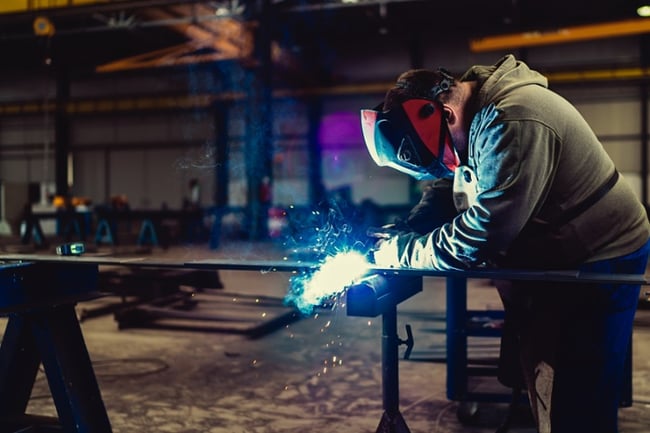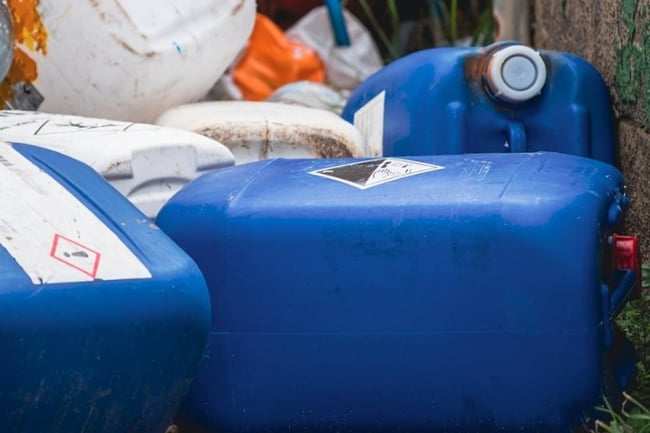To perform manufacturing processes, many businesses require a range of dangerous goods and hazardous chemicals. And while these chemicals may be handled and stored safely, thought may not be given to the chemical waste disposal of these products.
Furthermore, we speak to many businesses who don’t understand the obligations associated with the storage and disposal of the chemical waste produced during the manufacturing process.
Not only do you have to ensure safety with these chemicals, but there needs to be planning, training and reviews of the waste disposal processes associated with all aspects of dangerous goods in your operations.
In this post, we’ll be looking at the ways in which manufacturers produce chemical waste, and the regulations and requirements that apply to its disposal. We’ll also highlight some often-overlooked areas of the manufacturing process where chemical controls may not be properly introduced – and chemical waste management may not be implemented.
How Does Chemical Waste Occur During Manufacturing?
Chemical waste can occur in several ways during the manufacturing process.
These include:
- As a result of mixed chemicals
- As a result of contaminated chemicals
- As a result of excess chemicals that can’t be recycled
- Byproducts of the manufacturing process
- Waste produced as left over from production
- As a result of the manufacturing process

Manufacturing products can create waste in many ways, including as a result of the process or byproducts caused in manufacturing.
Why is Chemical Waste Dangerous?
Just like the chemicals that you’re using or storing, your chemical waste may create health hazards or physical hazards if it’s not handled, stored and disposed of in the right way.
Chemical waste must always be considered as a separate waste issue in your business – requiring specific controls and processes to ensure the waste management procedure actively reduces hazards until it’s been picked by your waste service.
Steps to Securing Chemical Waste During Manufacturing Processes
So how do you properly handle chemical waste? Here’s some simple steps to streamline the procedure.
Waste Storage and Disposal Precautions
- Develop a waste storage and disposal procedure that gets the waste out of the manufacturing facility as quickly as possible by trained personnel.
- Ensure the correct PPE is available and used by staff handling and managing the chemical waste.
Waste Storage Equipment
- Install compliant chemical storage suitable for the dangerous goods class.
- Check airborne contaminant levels in the storage area to ensure the vapours are within legal limits. If they aren’t, you will have to consider ventilation systems or a different area or procedure for waste storage.
- Select a chemical waste storage area that is out of the way of normal activities easily identifiable and safely accessible.
- Abide by all the usual segregation and hazard control rules that you would normally have for your in-use chemicals – as the hazards remain the same. For example, don’t put flammable gas cylinders next to oxidising gas cylinders, even when ‘empty’.
Chemical Waste Containers
- Treat empty chemical containers, such as gas cylinders or flammable liquid IBCs, as if they were full. Vapours and residue can still create hazards during the storage and disposal of waste.
- Segregate full and empty chemicals – never store them in the same storage unit
- Correctly label each waste container.
- Make sure all waste is in chemically compatible containers with a secure screw-top lid.

Even 'empty' chemical containers still pose a risk during the waste disposal process.
Prevent Leaks and Spills
- Ensure waste storage has a spill containment bund.
- Secondary containment systems may also be implemented to reduce spillage risk in the waste storage area.
Lithium-ion Batteries
- Remember to include safety procedures for lithium-ion battery disposal. These Class 9 dangerous goods must be disposed of as per the regulations in your local region, and in line with the local waste authority. Never throw these batteries or devices in the regular rubbish, as they can create a fire or explosion.
Staff Training
- Train staff in waste disposal processes, including correct storage, PPE and notification process for spills or accidents.
- Only allow authorised staff into the chemical waste storage area.
Emergency Response
- Emergency response equipment, including spill kits, fire extinguishers and alarm systems, should also be installed in waste areas due to the hazards involved with waste collection. Ensure your emergency planning includes your chemical waste disposal areas.
Waste Disposal Process
- Storage time should have a strict limit to reduce the likelihood of the chemical waste remaining at your site. Work with your hazardous waste collection service so the safest possible system can be established.
- Control vehicle access in the area due to the hazards present.
- Secure the waste storage area so that unauthorised entry is prohibited.
Unidentified Chemical Waste
If an error occurs, unidentified chemical waste may require processing.
Processing and disposal of any unidentified substances should be managed by a waste authority, with caution taken during the disposal process at your site. Always assume the chemical waste is hazardous, and take the relevant precautions to secure, isolate and label as such.
If your organisation creates an inventory of chemical waste, as well as firm handling and storage procedures, the likelihood of unknown substances appearing at your site should be limited.
Recycling for Chemicals
Where possible, you can recycle some dangerous goods or hazardous substances to reduce waste volumes. Items may include lithium-ion batteries, lead acid batteries, LPG bottles, paints, adhesives, varnishes, oils and other chemical products.
Visit the Planet Ark website or speak to your local waste authority to learn more about recycling your chemical waste.
REMEMBER: To reduce your waste during manufacturing, you can also adopt ‘greener’ habits. The implementation of sustainable manufacturing practices through ‘Lean Manufacturing’ can reduce negative environmental impacts while conserving energy and natural resources. These manufacturing practices can actively reduce waste onsite, as well as improve the cost of resources and production.
Waste Procedure Examples
Some examples of waste procedures may include:
Dangerous Goods: Paint - Class 3 Flammable Liquid
- Using manual handling equipment and suitable PPE For the product, transfer the paint tins to the refuse area.
- Mark the tins with the appropriate waste label.
- Update the waste inventory with the new waste products.
- Store paint tins in a Class 3 cabinet or outdoor store. Ensure segregation from ignition sources and incompatible substances.
- Arrange for pickup by your waste management authority.
Dangerous Goods: LPG - Class 2.1 Gas
- Using a gas bottle trolley and suitable PPE, transfer the empty gas cylinders to the refuse area.
Mark with the appropriate waste label and ensure any full cylinders are not near the empty ones. - Update the waste inventory with the new waste products.
- Store the gas cylinders in a gas cage, marked with the appropriate DG signage and hazard sigange.
- Ensure segregation from heat and ignition sources and incompatible gases and other dangerous goods.
- Arrange for pickup by your LPG gas bottle recycler.
Chemical Waste in your Business
The reduction and management of chemical waste is an important consideration for any business. But first, you must be able to successfully identify the hazardous substances and dangerous goods that you’re working with. For more information on how to increase safety at your site, download our free eBook. This will guide you through chemical identification so you can create a safer workplace for your team and community.
Joining the team as a Dangerous Goods Storage Consultant, Melissa Hampton became Storemasta's Marketing Manager in late 2021. With extensive knowledge and experience in chemical compliance, Melissa is responsible for leading the Marketing team and helping shape their marketing strategy. In her spare time, you can find Melissa hiking, swimming and enjoying the great outdoors in beautiful north-west Tasmania.
